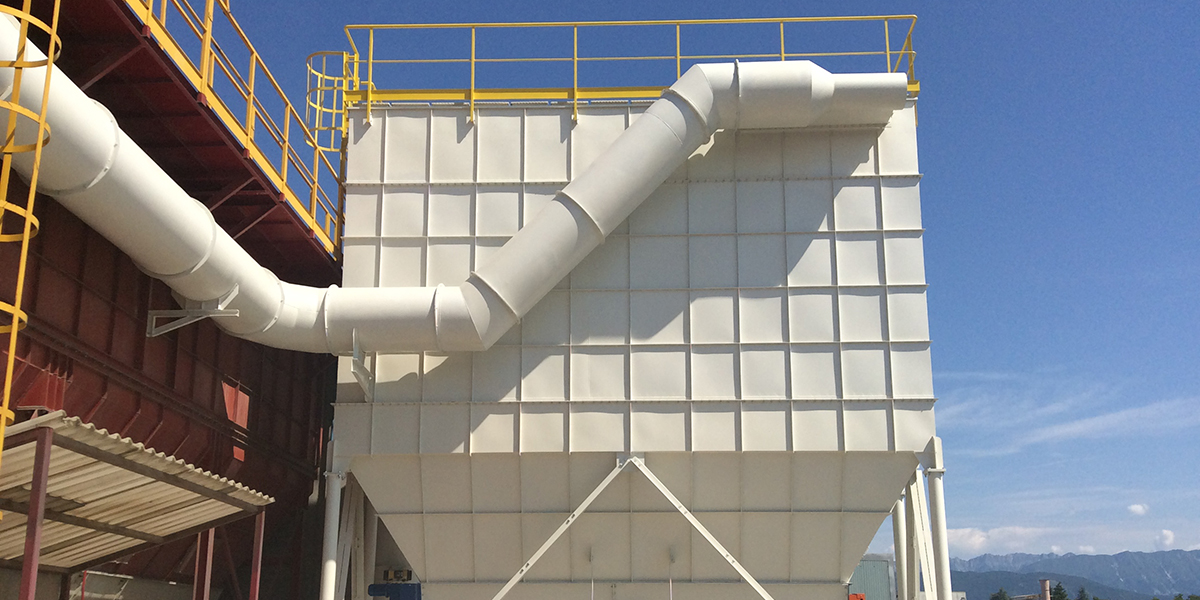What is a bag filter and how does it work? In this article, we will also look at the main industries where it is used and the benefits it provides.
Bag filters are systems intended for the dedusting of gaseous currents present in various companies, in particular within cement factories, incinerators, steel mills and generally wherever there is a conspicuous handling of dusty materials. These filters consist in peculiar fabric sleeves which can be made up of different filtering media, to be defined according to the specific needs: polyester, aramid, fiberglass or Teflon; they are placed inside cages and fixed to venturi tubes. By passing inside of them, the air is cleaned and returned to the environment free of impurities and potentially harmful dusts.
Bag filters operating principle
Bag filters base their design on the principle of physical separation which can take place by means of a filtering fabric and below we will try to explain their operating mechanism in a clear and simple way. First, however, we specify that bag filters operate through a combination of mechanical capture mechanisms, according to which:
- Coarse particles are removed by impact: given their inertia, in fact, they continue their motion in a rectilinear way impacting against the external surface of the sleeves.
- Medium-sized particles are eliminated by direct interception: having a lower inertia they rotate around the sleeves by touching them sideways and therefore being blocked in this area.
- Smaller particles are removed by diffusion because, due to their lightness, they are not transported uniformly by the air, inevitably bringing them into contact with the fibre of the sleeve.
Gases saturated with dust and conveyed by special fans, usually placed at the end of the system to prevent the particulate from damaging them and to keep the system in depression, enter the filter through a nozzle and meet a series of fabric sleeves. The latter can be made of different materials and are previously treated in such a way as to be permeable, allowing the passage of gas but not of dust which, on the contrary, adhere to the surface. Clean air, on the other hand, passes through the sleeves and exits through a special nozzle to be returned to the atmosphere.
In this way, dusts are blocked inside the sleeves, on which a layer of particulate is usually formed which, thanks to a compressed air shaking system, is periodically removed, transported and stored through special conveyor systems, to then be disposed of. The compressed air released at regular intervals at a pressure of about 6 bar, causes a shock wave that causes the particles attached to the sleeve to detach.
In this way, dust particles are blocked inside the sleeves. A particulate layer is usually formed on them and, thanks to a compressed air shaking system, is periodically removed, transported and stored through special conveyor systems, to then be disposed of. The compressed air released at regular intervals at a pressure of about 6 bar, produces a shock causing the particles stuck to the sleeves to detach.
Where are bag filters used?
It should be noted that there are different types of bag filters that vary according to the loads of dust to be removed and the type of industrial application. Therefore, we can define two main models of bag filters: those intended for industrial plants that require medium-light solutions and those customized and specifically designed to cope with much more considerable masses
Bag filters are recommended for companies that deal with:
- Sandblasting
- Polishing
- Grinding
- Edgebanding
- Dry processings on machine tools
- Chemical processings
- Pharmaceutical processings
- Processings of plastics
- Marble cutting
- Silo Vent
- Combustion of solid materials and waste
- Drying of solid and assimilable materials
- Sanding
- Foundries
- Mixing
- Pneumatic transport
- Mixing and weighing of powdery solid materials.




